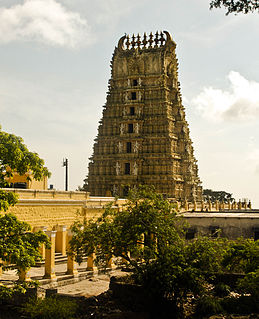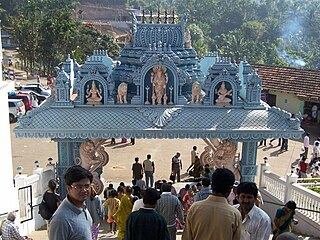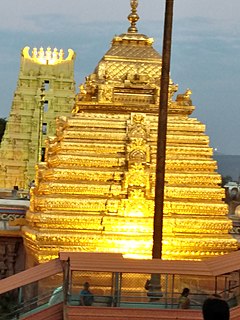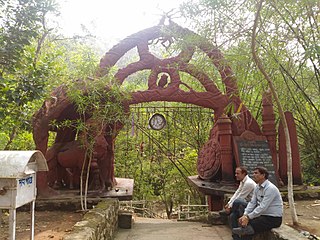
Hayagriva, also spelled Hayagreeva, is a Hindu deity, the horse-headed avatar of Vishnu. The purpose of this incarnation was to slay a danava also named Hayagriva, who had the neck of a horse and the body of a human.

Kodachadri is a mountain peak with dense forests in the Western Ghats in South India, 78 km from Shimoga. It is declared as natural heritage site by the Karnataka Government. and it is 13th highest peak of Karnataka.

Tripura Sundari, also known as Rajarajeshwari, Shodashi, Kamakshi, and Lalita is a Hindu goddess, worshipped as a principal aspect of supreme goddess Mahadevi mainly venerated in Shaktism, the goddess-oriented sect of Hinduism. She is also a prominent Mahavidya. She is glorified in many Shakta texts, with Lalita Sahasranama, Soundarya Lahari being the most popular one. She is known as Adi Parashakti in Lalitopakhyana of Brahmanda Purana.

Temple cars are chariots that are used to carry representations of Hindu gods. The car is usually used on festival days, when many people pull the cart.

The Chottanikkara Devi Temple is a famous temple of supreme mother goddess Bhagavati. She is a form of Mahalakshmi. She is believed to be residing in Chottanikkara along with her husband Maha Vishnu. The temple is located at Chottanikkara, a southern suburb of the city of Kochi in Ernakulam district, in the state of Kerala, India and is one of the most popular temples in the state. In terms of temple architecture, the Chottanikkara temple stands out to be an ultimate testimonial to the ancient vishwakarma sthapathis along with Sabarimala temple. Sree Mahamaya Bhagavati, the goddess of Saraswathi, Lakshmi, and Parvati is one of the most popular deities in Kerala and the supreme mother goddess in Hinduism. Chottanikkara Devi is worshipped at the temple, in three different forms: as Mahasaraswati in the morning, draped in white; Mahalakshmi in noon, draped in crimson; and as Mahaparvati in the evening, decked in blue. Devotees used to chant "Amme Narayana, Devi Narayana, Lakshmi Narayana, Bhadre Narayana" in this temple. Goddess 'Keezhkkaavu bhagavathi' is believed to be Bhadrakali, in her fierce form or Ugra form. Bhadrakali, is a form of mother Kali, supposed to be born from the third eye of lord Shiva, to kill the demon king Darika. People suffering from mental illnesses and commonly visit the temple, as Chottanikkara Devi is said to cure her devotees. Guruthi pooja is a ritual done in the late evening to invoke the goddess Mahakali. Earlier 'Guruthi Pooja' was done only on Fridays. But nowadays, it is performed every day.

Kotilingeshwara Temple a temple in the village of Kammasandra in Kolar district, Karnataka, India. The Kammasandra village was earlier known as Dharmasthali. The presiding deity of the temple is Lord Shiva. The temple has one of the largest Shivalingams in the world. A short drive from Bangalore to Kolar, about 70 km leads you to Kotilingeshwara Temple. Just 70 km away, the Kotilingeshwara temple visit offers something for everyone and can be done in half a day.
Kollur is a village in the southern state of Karnataka, India. It is located in the Byndoor taluk of Udupi district in Karnataka.

Gokarna is a small temple town located 32 km (20 mi) away from Kumta and 80 km (50 mi) from Sirsi, It has a population of around 20,000. The main temple and deity is Shiva, who is also known as Mahabaleshwara. This temple houses what is believed to be original image of Shiva's linga (Atmalinga). There are many other temples all over this small town. Ankola and Kumta on NH66 are the main towns near Gokarna where almost all trains have halts and are connected to major cities like Chennai, Bangalore, Hyderabad, Mangalore and Mumbai through bus service.

The Chamundeshwari Temple is a Hindu temple located on the top of Chamundi Hills about 13 km from the palace city of Mysuru in the state of Karnataka in India. The temple was named after Chamundeshwari or, the fierce form of Shakti, a tutelary deity held in reverence for centuries by the Maharaja of Mysuru.

The Annapoorneshwari Temple is a Hindu temple dedicated to the goddess Annapoorneshwari (Annapoorna), located at Horanadu, Karnataka, India, 100 km from Chikmagalur in the thick forests and valleys of the Western Ghats of Karnataka. It is situated on the banks of river Bhadra.
Temples of the Indian State of Karnataka illustrate the variety of architecture prevalent in various periods. The architectural designs have found a distinguished place in forming a true atmosphere of devotion for spiritual attainment.

Maranakatte is located at a distance of 16 km from Kundapura on the way to Kollur and the village is also called Kanchinakodlu. There is a Brahmalingeshwara Temple which is located on the banks of river Brahmakunda in the northside which then takes a steep turn towards east which increases the beauty of the spot.

The Mahabaleshwar Temple, Gokarna is a 4th-century CE Hindu temple located in Gokarna, Uttara Kannada district, Karnataka state, India which is built in the classical Dravidian architectural style. It is a site of religious pilgrimage. The temple faces the Gokarna beach on the Arabian Sea. The temple deifies the Pranalinga also called Atmalinga or Shiva Linga In legend, it is said that the deity of the temple will bestow immense blessings to devotees, even to those who only glimpse it. Currently the administrative charge of the temple is with an Overseeing Committee under the Chairmanship of Justice BN Srikrishna, a Retired Justice of the Hon'ble Supreme Court of India.

Sri Bhramaramba Mallikarjuna Temple or Srisailam Temple is a Hindu temple dedicated to the deities Shiva and Parvati, located at Srisailam in the Indian state of Andhra Pradesh.

A Jyotirling or Jyotirlingam, is a devotional representation of the Hindu god Shiva. The word is a Sanskrit compound of jyotis 'radiance' and linga. Śiva Mahāpurāṇa mentions 64 original jyotirlinga shrines in India, 12 of which are most sacred and they are called the Maha Jyotirlingam.
Sri Dwadasha Jyotirlinga Temple is located in Bangalore, in the state of Karnataka, India. The temple is located in Omkar Ashram, in Omkar Hills Bangalore. Omkar Hills in Srinivasapura is one of the highest points of Bangalore. The Sri Dwadasha Jyotirlinga Devasthana is unique, and one of the most magnificent and gigantic temples in Karnataka.
Kollura Sri Mookambika is a 1993 Indian Kannada-language Hindu mythological film, directed and produced by Renuka Sharma. Chi. Udaya Shankar has written the story and screenplay and Pughalendi Mahadevan has scored the music. The film stars Sridhar, Bhavya and Vajramuni. The film is centered on the Goddess Mookambika.

The Bhimeswar Dwadas Jyotirlinga Dham, one of the Jyotirlingas, is located at Dakini hill near Pamohi in Guwahati. It is situated at the hill just besides the Deepor Beel. It is believed that Lord Shiva had incarnated here to destroy a demon called Bhimasura and protect his devotees.
Veerabhadra Temple is located on Devakuta Parvatham, a hillock on an islet amidst the Godavari River near Pattiseema in West Godavari, Andhra Pradesh. The temple is dedicated to Shiva and the namesake is Veerabhadra.

Mookambika Kannada ಶ್ರೀ ಮೂಕಾಂಬಿಕಾ is the Hindu goddess who is representing Adi Parashakti. She is said to be the mother of the universe representing Adi Parashakti. Shakti refers to the cosmic energy that permeates everything. Adi Parashakti manifests as Saraswati, Lakshmi & Parvati Ambika, Sridevi, Kamala Devi, Kali, Chamundi, Uma, Kamakshi, Vidhya, and in countless other forms. Mother presides over creation, preservation, and destruction.
















